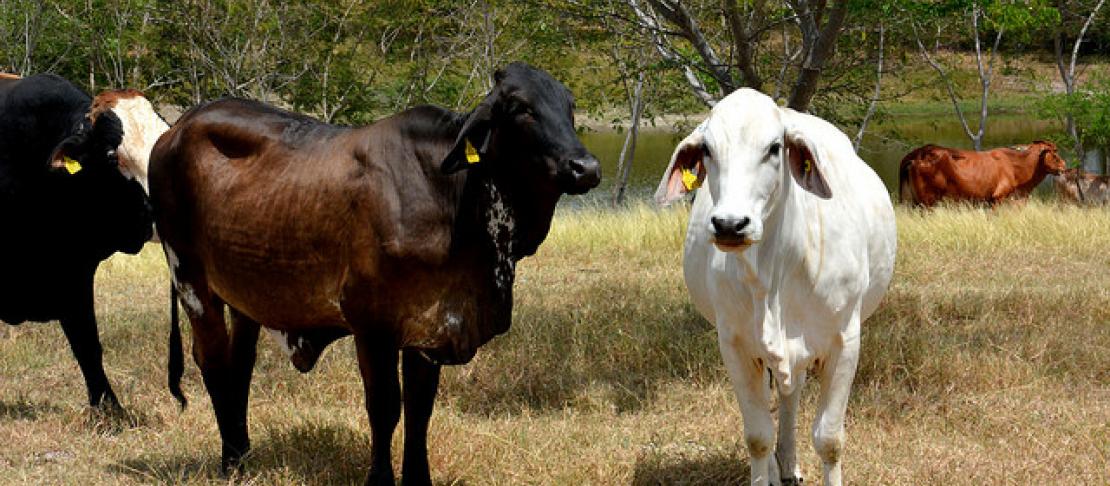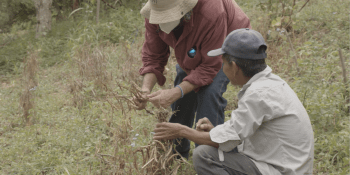Improving reporting for agricultural emission reductions in the livestock sector

Innovations for improved reporting of mitigation in the livestock sector demonstrate progress towards national climate commitments.
To help track progress on countries’ mitigation pledges for Paris Agreement, the CGIAR Research Program on Climate Change, Agriculture and Food Security (CCAFS) and the International Livestock Research Institute (ILRI) facilitated a science-policy dialogue on measurement, reporting and verification (MRV) of mitigation in the livestock sector on 7 November at COP22 in Marrakech, Morocco. The dialogue was conducted in collaboration with the Global Research Alliance on Agricultural Greenhouse Gases (GRA) and the Food and Agriculture Organization of the United Nations (FAO).
61 countries plan to reduce livestock emissions under the Paris Agreement, yet the methods most developing countries use to assess emissions are not yet sufficient to capture the impacts of climate change mitigation practices.
Watch the video from the event:
MRV of national greenhouse gas inventories using the simplest reporting, called Tier 1 reporting, calculates livestock emissions based only on number and kinds of animals, meaning that it cannot capture emission reductions caused by changes in agricultural practices. Thus, countries that aim to achieve mitigation in the livestock sector need to use advanced greenhouse gas inventories that both capture a wide range of potential mitigation actions and can inform national strategies and policies.
To better understand how countries are tackling MRV of livestock emissions, experts from Brazil, Costa Rica, Ethiopia, Indonesia, and Uruguay – all of which are seeking to reduce their livestock emissions – presented their countries’ activity data collection systems, how they improved emission factors, and how they coordinate across government offices.
See the presentations from the side event:
Getting accurate, up-to-date activity data - such as herd numbers and composition, diet, use of nitrogen fertilizer, use of mitigation options, and grassland expansion - is a challenge for most counties. National statistics often fall short, and collecting data from extension agents or farmers who may have only a few head of cattle is inefficient.
Uruguay has taken steps to develop high quality national statistics on livestock (Sistem Nacional de Informacion Ganadería). Walter Oyhandçabal, Director of the Sustainability and Climate Change Unit in the Ministry of Livestock, Agriculture and Fisheries of Uruguay, reported that Uruguay now uses electronic and visual tags to achieve 100% real-time traceability of livestock emissions. Farmers also make annual electronic reports of the numbers of head by type and diet. This allows classification of animals by production system (e.g. breeding, fattening) and share of grassland region by seven ecoregions in the country. Data are spatially disaggregated by cattle herd, category, diet quality, and composition.
To improve emissions data, countries produced country-specific emissions factors in addition to using IPCC data where country-data did not exist.
Bess Tiesnamurti, Director of the Indonesian Centre for Animal Research and Development, reported that country-specific emissions factors for Indonesia were higher for male cattle than the emissions estimated using default factors for Asia.
Zewdu Eshetu, Director of the Climate Science Center at Addis Ababa University in Ethiopia, noted that because livestock emissions vary by health, diet quality, management, and milk productivity of animals, it is difficult to develop precise emission factors without using Tier III approaches. He observed that in Ethiopia, rural mixed crop-livestock systems and pastoral and agropastoral systems contributed the bulk of emissions, but were also more variable than small-scale or medium-scale commercial dairy operations, limiting the precision of their emissions estimates.
Compilation and coordination of data remains a huge problem in reporting.
Having good quality data is important for multiple reasons,” said Agripina Jenkins Rojas, Ministry of Agriculture and Livestock. “Costa Rica uses activity data to support decision-making on livelihoods and food security as well.”
Agripina described how Costa Rica is addressing coordination through their Sistema Nacional de Informasión Ambiente (SINIA), which provides protocols and methodologies to their Sistema Nacional de Métrica de Cambio Climático (SINAMECC), which in turn enables inter-institutional information exchange among units concerned with mitigation, adaptation, finance, and co-benefits. Their data platform also meets the needs of carbon registries.
Similarly, Brazil is using MRV not just for reporting on NDCs, but also for informing national programs, such as the Carbon Neutral Meat initiative (a carbon label) and the Sectoral Plan for the Mitigation and Adaptation to Climate Change for a Low Carbon Emission Agriculture (ABC Plan), which offers a special line of credit and financial support for mitigation actions. An ABC platform serves as a place to compile data on GHG emissions from agriculture and to estimate the overall impact of the ABC Plan.
Examples of mitigation options that countries used and want to track include: supplementation with leguminous shrubs, use of urea-molasses multi-nutrient blocks, use of urea-treated crop residues, supplementation with low-cost high protein energy concentrates, use of probiotics (Acetoanaerobium noterae and A. woodii), and complete rumen modifiers and disease control (e.g. trypanoosomiasis in Ethiopia).
Participants in the dialog concluded that simple approaches to measurement and verification will be needed, and recommended:
- Focusing data collection on feed consumption, breeds, and feeding types
- Determining the sample frequency and locations that best capture livestock systems.
Participants also identified needs for more frequent activity data to capture changes annually and over time and to develop MRV for integrated systems of grass, trees, and livestock. Countries also need models calibrated to local conditions and tools that are simple and reduce uncertainty. South-south learning, improved data sets and tools, and technical support from research networks should be used to achieve MRV that is feasible, transparent, and produces higher levels of confidence.
We have agreed that MRV systems need to be reliable, accurate, and capture mitigation. We see that coordination of stakeholders at the national level is needed in every country in order to compile activity data and calculate the most relevant emissions factors," Robin Mbae, Deputy Director for Livestock Production and Head of the Climate Change Unit in the State Department of Livestock in the Ministry of Agriculture, Livestock and Fisheries of Kenya, said. "We also acknowledge that additional research is needed to develop emission factors for different production systems and to produce models relevant to countries’ diverse conditions.”
This side event is part of a larger project on improving MRV for livestock, conducted together with the United States Agency for International Development (USAID), Unique Forestry and Land Use, ILRI, the International Center for Tropical Agriculture (CIAT), the World Agroforestry Centre (ICRAF), GRA, and FAO. In 2017, CCAFS and partners will produce a white paper reviewing country experiences in MRV, a workshop for countries to exchange experiences, and guidelines to support countries’ needs for technical assistance in MRV in the livestock sector. CCAFS also recently published guidelines for measurement of enteric fermentation.
See the full country presentations from the side event (with additional background information):
For more information about CCAFS’ support for MRV in the livestock sector, please contact julianna.m.white@uvm.edu.
Lini Wollenberg is the flagship leader for low emission development research at CCAFS.
Julianna White edited this article.



